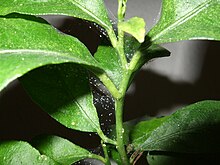Spider mites
| Spider mites | ||||||||||||
|---|---|---|---|---|---|---|---|---|---|---|---|---|

Common spider mite ( Tetranychus urticae ) |
||||||||||||
| Systematics | ||||||||||||
|
||||||||||||
| Scientific name | ||||||||||||
| Tetranychidae | ||||||||||||
| Donnadieu , 1876 |
The spider mites (Tetranychidae) are a family of about 1,200 species of the suborder Prostigmata within the subclass of the mites . Spider mites generally live on the underside of plant leaves, where they spin fine webs for protection and feed on sap. Since they puncture the epidermal cells of the leaves for food intake , they can damage the plant. Spider mites are known for several hundred plant species.
Spider mites are found worldwide. Some species of spider mite are pests of enormous economic importance, such as the red spider ( Panonychus ulmi ), the common spider mite ( Tetranychus urticae ) or the linden spider mite ( Eotetranychus tiliarum ).
features
Spider mites have a more or less pronounced pear-shaped shape and reach a body length of 0.25 to 0.8 mm. They are yellowish, greenish, orange or red in color. The fourth phalanx of the pedipalp has a claw-like appendage and on the idiosoma there are at most 16 pairs of hairs. The larvae have three pairs of legs, the nymphs and after two, sometimes three stages developing imagines , however, have four pairs of legs.
The name-giving ability in German to produce a spider thread is only found in the subfamily of the Tetranychinae and is there mediated by a large, single-celled gland at the tip of the pedipalp, the secretion of which is spun into a double thread with a hollow bristle on each of the pedipalps.
Internal system
The family includes the following subfamilies , tribes and genera :
- Subfamily Bryobinae Berlese
- Tribe Bryobini high bar
- Genus Bryobia Koch
- including the red gooseberry mite ( Bryobia ribis ) and the American meadow mite ( Bryobia pratensis )
- Genus Bryobiella Tuttle & Baker
- Genus Eremobryobia Strunkova & Mitrofanov
- Genus Hemibryobia Tuttle & Baker
- Genus Marainobia Meyer
- Genus Mezranobia Athias-Henriot
- Genus Neoschizonobiella Tseng
- Genus Pseudobryobia McGregor
- Genus Sinobryobia Ma et al.
- Genus Strunkobia Livshitz & Mitrofanov
- Genus Toronobia Meyer
- Genus Bryobia Koch
- Tribe Bryobini high bar
- Tribe Hystrichonychini Pritchard & Baker
- Genus Afronobia Meyer
- Genus Aplonobia Womersley
- Genus Beerella Wainstein
- Genus Bryocopsis Meyer
- Genus Dolichonobia Meyer
- Genus Hystrichonychus McGregor
- Genus Magdalena Baker & Tuttle
- Genus Mesobryobia Wainstein
- Genus Monoceronychus McGregor
- Genus Notonychus Davis
- Genus Parapetrobia Meyer & Rykev
- Genus Paraplonobia Wainstein
- Genus Peltanobia Meyer
- Genus Porcupinychus Anwarullah
- Genus Tauriobia Livshitz & Mitrofanov
- Genus Tetranychopsis Canestrini
- Tribe Hystrichonychini Pritchard & Baker
- Tribus Petrobiini high bar
- Genus Dasyobia Strunkova
- Genus Edella Meyer
- Genus Lindquistiella Mitrofanov
- Genus Neotrichobia Tuttle & Baker
- Genus Petrobia Murray
- Genus Schizonobia Womersley
- Genus Schizonobiella Beer & Lang
- Tribus Petrobiini high bar
- Subfamily Tetranychinae Berlese
- Tribe Eurytetranychini horizontal bar
- Genus Anatetranychus Womersley
- Genus Atetranychus Tuttle et al.
- Genus Aponychus Rimando
- Genus Duplanychus Meyer
- Genus Eurytetranychoides Reck
- Genus Eurytetranychus Oudemans
- Genus Eutetranychus Banks
- Genus Meyernychus Mitrofanov
- Genus Paraponychus Gonzalez & Flechtmann
- Genus Sinotetranychus Ma & Yuan
- Genus Synonychus Miller
- Tribe Eurytetranychini horizontal bar
- Tribe Tenuipalpoidini Pritchard & Baker
- Genus Crotonella Tuttle et al.
- Genus Eonychus Gutierrez
- Genus Tenuipalpoides Reck & Bagdasarian
- Genus Tenuipalponychus Channabasavanna & Lakkundi
- Tribe Tenuipalpoidini Pritchard & Baker
- Tribe Tetranychini horizontal bar
- Genus Acanthonychus Wang
- Genus Allonychus Pritchard & Baker
- Genus Amphitetranychus Oudemans
- Genus Atrichoproctus Flechtmann
- Genus Brevinychus Meyer
- Genus Eotetranychus Oudemans
- therein the linden spider mite ( Eotetranychus tiliarum )
- Genus Evertella Meyer
- Genus Hellenychus Gutierrez
- Genus Mixonychus Meyer & Ryke
- Genus Mononychellus Wainstein
- Genus Neotetranychus Trägerårdh
- Genus Oligonychus Berlese
- Genus Palmanychus Baker & Tuttle
- Genus Panonychus Yokoyama
- in it the red spider ( Panonychus ulmi )
- Genus Platytetranychus Oudemans
- Genus Schizotetranychus Tragårdh
- Genus Sonotetranychus Tuttle et al.
- Genus Tetranychus Dufour
- therein the common spider mite ( Tetranychus urticae ) and the hawthorn spider mite ( Tetranychus viennensis )
- Genus Xinella Ma & Wang
- Genus Yezonychus Ehara
- Genus Yunonychus Ma & Gao
- Tribe Tetranychini horizontal bar
Individual evidence
- ↑ a b Horst Börner: Plant diseases and plant protection. 8th, revised and updated edition. Springer, Berlin et al. 2009, ISBN 978-3-540-49067-8 , pp. 181-184.
- ^ A b Alfred Kaestner (founder): Textbook of special zoology. Volume 1: Hans-Eckhard Gruner (Ed.): Invertebrates. Part 4: Hans-Eckhard-Gruner, Manfred Moritz, Wolfram Dunger: Arthropoda (without Insecta). 4th, completely revised and greatly expanded edition. Gustav Fischer, Stuttgart 1993, ISBN 3-334-60404-7 , pp. 374-375.
- ^ Hans R. Bolland, Jean Gutierrez, Carlos HW Flechtmann: World Catalog of the Spider Mite Family (Acari: Tetranychidae). Brill, Leiden et al. 1998, ISBN 90-04-11087-9 , pp. 5-11 : Key to the Genera of the World.
